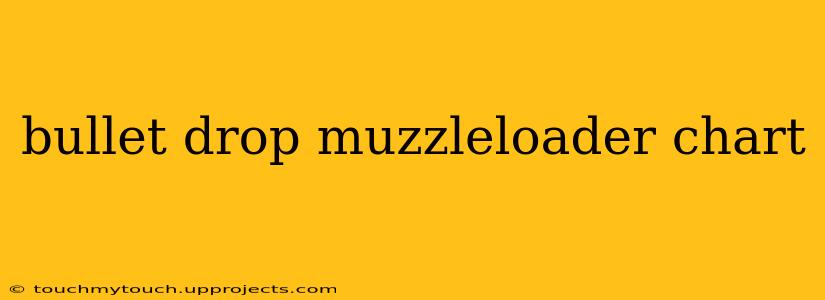For muzzleloader enthusiasts, understanding bullet drop is crucial for achieving accurate shots at varying distances. Unlike modern firearms with telescopic sights and readily available ballistic data, muzzleloading presents a unique challenge demanding a deeper understanding of projectile trajectory. This guide delves into the complexities of bullet drop in muzzleloaders and provides a framework for creating your own personalized chart. We'll explore the factors influencing bullet drop and offer practical tips to improve your shooting accuracy.
Factors Affecting Muzzleloader Bullet Drop
Several factors interact to determine bullet drop in muzzleloading rifles. Accurately predicting bullet drop requires careful consideration of these elements:
1. Projectile Characteristics:
- Bullet Weight: Heavier bullets generally experience less drop due to their higher momentum. A heavier bullet retains its velocity better over distance.
- Bullet Diameter & Shape: The bullet's diameter relative to the bore (the degree of bullet fit) and its aerodynamic shape significantly influence its trajectory. A well-fitted, aerodynamically designed bullet will experience less air resistance and thus less drop.
- Bullet Material: The material composition affects the bullet's weight and density, which directly impacts trajectory.
2. Muzzle Velocity:
Higher muzzle velocity translates to a flatter trajectory and reduced bullet drop. Muzzle velocity is greatly affected by:
- Powder Charge: Increasing the powder charge generally increases muzzle velocity (up to a point – too much powder can lead to decreased accuracy and potentially damage your firearm).
- Powder Type: Different black powders and substitutes exhibit varying burn rates, influencing muzzle velocity.
- Barrel Length: Longer barrels generally impart higher muzzle velocities.
3. Environmental Conditions:
Environmental factors significantly influence bullet drop:
- Air Density: Higher air density (cooler temperatures, higher barometric pressure) increases air resistance, leading to greater bullet drop. Lower air density has the opposite effect.
- Wind: Wind affects trajectory in both horizontal and vertical directions. Headwinds increase bullet drop, while tailwinds reduce it. Crosswinds affect horizontal accuracy.
Creating Your Own Muzzleloader Bullet Drop Chart
There's no single, universally applicable bullet drop chart for muzzleloaders. The best approach is to create a personalized chart based on your specific firearm, ammunition, and typical shooting conditions. Here’s how:
1. Conduct Range Testing:
This is the most reliable method. You'll need access to a safe shooting range with clear backstops at various distances. Shoot multiple rounds at each distance (e.g., 50 yards, 75 yards, 100 yards, etc.), carefully noting the point of impact relative to your point of aim. Record your environmental conditions (temperature, barometric pressure, wind speed and direction) for each test session.
2. Data Analysis and Chart Creation:
Once you've gathered data, analyze the results. Plot your data on a chart with distance on the x-axis and bullet drop (in inches or centimeters) on the y-axis. This will provide a visual representation of your bullet’s trajectory under your specific conditions.
Tips for Improving Muzzleloader Accuracy
Beyond understanding bullet drop, several practices enhance muzzleloader accuracy:
- Proper Cleaning and Maintenance: A clean barrel is essential for consistent performance.
- Consistent Loading Technique: Maintain consistent powder charges and bullet seating depth for repeatable results.
- Practice and Familiarity: Regular practice helps you understand your firearm's idiosyncrasies and develop consistent shooting technique.
Conclusion
Creating a personalized bullet drop chart for your muzzleloader is a vital step in becoming a proficient and accurate shooter. Remember to prioritize safety, and always follow responsible firearm handling practices. By understanding the factors influencing bullet drop and employing consistent testing and analysis, you can significantly improve your accuracy at various ranges.
